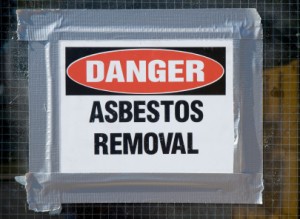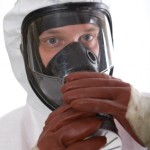
Many people think asbestos is only a problem in houses built before the mid 1950s. But, the reality is, you'll find significant amounts of asbestos in homes built right up until the early 1980s. And this makes this once lauded, now loathed, building material a real cause for caution for nearly all home renovators.
Why is asbestos so prevalent?
The word 'asbestos' means inextinguishable, an attribute that was discovered and exploited by the Finns as far back as 3000 BC. In modern times, asbestos was used worldwide in more than 3000 different products for the building industry between the early 1900s and the 1980s. Asbestos was popular because of its fire resistance and durability, its thermal, acoustic and anti-rot qualities, and its resistance to vermin and termites.
Locally, about 90 per cent of all asbestos production was to make asbestos cement sheeting. This was for flat sheets (for walls, ceilings and floors), corrugated sheets (for roofing) and decorative finishes. Other asbestos-based products that were used to build homes included water, drainage and flue pipes, roofing shingles, guttering, some vinyl floor coverings, bitumen-based waterproofing membranes, insulation, textured paint and the list goes on.
The manufacture and use of asbestos products was officially banned in Australia in 2003.
Why is it harmful?
Asbestos is comprised of microscopic, separable fibres which, if inhaled in high numbers over an extended period, can cause asbestosis, lung cancer and mesothelioma. And as the symptoms of these deadly diseases don't usually appear until 20-30 years after initial exposure, there is a real danger for repeat home renovators and their families.

A typical Aussie fibro, or 'Fibrolite', cottage
such as this poses no risk to your health
provided the asbestos products are
stable and in good condition.
What are the risks for renovators?
Just because your home contains materials made with asbestos, it doesn't mean your health is automatically at risk. Occupational health and safety experts like Philip Hibbs from Hibbs & Associates Pty Ltd, a NSW firm specialising in environmental risk management, say the health threat occurs when people mishandle asbestos products and in doing so disturb and release the harmful fibres. One example is the use of power tools to cut through or drill into asbestos cement sheeting.
According to Mr Hibbs, if asbestos materials are stable and in good condition, they pose very little risk to health, and more so for bonded materials. The term 'bonded' means the asbestos fibres are firmly bound into the matrix of the material, such as cement sheet, for example. If undamaged, these products do not release fibres readily.
Weathered materials, however, especially asbestos roofing materials, can pose a real risk. Weathering eats away at the cement surface of the roofing and the result is a thin friable surface which easily releases asbestos fibres.
TIP: If you have an asbestos sheet roof, never clean it with a water blaster, keep gutters and downpipes in good condition and ensure they are plumbed into the municipal storm-water system. Downpipes must not be allowed to run into garden beds.

If a Hazardous Materials Survey finds asbestos in your project area, you will need to call in a licensed asbestos removal contractor to ensure its safe removal and disposal.
How can I be sure I'll be renovating safely?
For home renovations requiring Development Application (DA) approval, most councils require a Hazardous Materials Survey to be conducted. This means you'll be made aware of the location of any asbestos products you have in the area to be renovated. It also means you'll have to hire a licensed asbestos removal contractor to ensure the material's safe removal and disposal. You will need to factor in costs of asbestos removal into you budget.
For home improvements that don't require a DA, however, the onus will be on you to have your project area tested if you suspect asbestos might be present. You will also need to hire an asbestos disposal contractor if the area of asbestos sheeting to be removed is over 10sqm. In NSW, the removal of asbestos materials must be conducted by an asbestos removal contractor licensed by the WorkCover Authority NSW. And although it seems obvious, it's worth mentioning that it is illegal to put asbestos waste in domestic garbage bins when removing.
To find a local asbestos disposal contractor, visit your state or territory's WorkSafe Australia website and check out the service provider directory.
Tips for handling asbestos sheeting yourself
When doing work around your home, it is okay to handle bonded asbestos products yourself, provided the total area of asbestos sheeting does not exceed 10sqm. But as even this amount can pose health risks, you need to protect yourself, your family and your neighbours by following these simple guidelines.
1. Never use power tools on asbestos sheeting
2. Wear a suitable Australian Standards approved respirator (Class P1) and disposable overalls
3. Wet sheets down to limit dust
4. Where practical, minimise the breakage and remove sheets whole
5. Wrap and seal sheets in 200-micron-thick plastic sheeting
6. Wrap your overalls and mask in a bag for disposal too
7. Contact your local council for an authorised disposal site in your area
8. Remove asbestos as soon as possible
If you suspect an asbestos contamination
If you think your home or an area of your garden is contaminated with asbestos fibres, you need to take these initial precautions to minimise everybody's risk of exposure.
1. Don't disturb the area by sweeping, vacuuming or raking
2. Spray the area gently with water to keep dust particles down
3. Cover with a plastic sheet or tarpaulin
4. Keep pets and children away
5. Contact your local council or a qualified occupational hygiene consultant. The Australian Institute of Occupational Hygeinists, Inc. www.aioh.org.au is also a great reference source.
The costs of asbestos removal can be expensive, so shop around, you will be amazed at the price differences.
Do the right thing
Removing asbestos may sound like a whole lot of hassle, but the inescapable fact is asbestos is a well documented killer of people who have had high levels of exposure to its deadly fibres. But if you follow the laws and safe procedures for working with asbestos, your chance of inhaling the fibres and risking your health and your family's health is extremely low.
